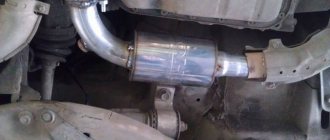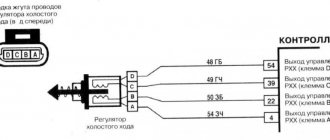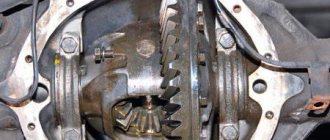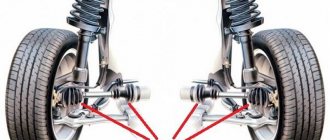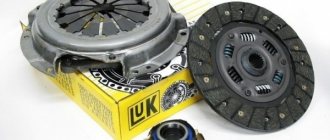Automatic transmissions are becoming increasingly popular in our country, and the share of cars with automatic transmission is growing rapidly.
Automatic transmissions transmit torque from the engine to the wheels of the car, automatically increasing or decreasing the gear ratio, adapting to optimal engine operating conditions. The classic automatic transmission consists of a torque converter and a number of planetary gears. The automatic transmission, smoothly shifting gears, provides the car with a smooth ride and makes driving a pleasure. In our article, we will look at the design and operating principle of an automatic transmission, list the main types of automatic transmissions, get acquainted with the operating modes, and analyze the advantages and disadvantages of automatic transmissions.
What is automatic transmission
An automatic transmission (AT) is a transmission that independently determines the most appropriate gear ratio depending on the current speed limit. The automatic transmission, without driver intervention, selects and switches the desired gear ratio, adapts to the speed set by the driver, and ensures a smooth start and smooth ride of the vehicle. The automatic transmission removes the lion's share of the load from the driver while driving compared to a classic manual transmission.
Since there are now different options for automatic transmissions (robots and CVTs), to avoid confusion, automatic transmissions are also called: classic automatic, hydraulic automatic, hydromechanical transmission, planetary automatic.
The history of the automatic transmission
The idea of creating an automatic transmission belongs to the German engineer Hermann Fettinger, who developed the first torque converter in 1902, and at first such a transmission was used only for the construction of ships.
The first car equipped with a planetary automatic transmission was the American Ford T. After the release of this car, the most active role in the development of automatic transmissions was played by General Motors, which managed to release a semi-automatic transmission in the mid-1930s. The same GM created the first completely automatic transmission in 1940
Automatic communism: how automatic transmission was developed in the USSR
At the end of the last century, domestic motorists saw with their own eyes unprecedented automotive options - electric mirrors and windows, air conditioners and automatic transmissions, which in our time have become commonplace even in the budget segment. But it’s curious that similar “bells and whistles” were also found on Soviet cars! Today we will talk about the history of the appearance and technical features of automatic transmissions on Soviet passenger cars.
Start
Back in the thirties, the USSR began to seriously study hydraulic couplings and torque converters, for which the Bureau of Hydraulic Gearboxes was created in Leningrad.
Automatic transmission device
An automatic transmission has a complex structure and the mechanism itself, through which gear shifting is ensured, is complex. The essence of this process comes down to turning the clutches and brakes on and off using the pressure of the working fluid.
There are several types of automatic transmissions that have some differences in design, but their basic elements are the same.
- Hydraulic transformer (torque converter)
. It is a metal body that is filled with a special working ATF fluid (oil). Its main task is to transmit rotation from the engine to the gearbox. In fact, this is an analogue of the clutch in a manual transmission. Consists of pump, turbine and reactor wheels, locking clutch and freewheel. The wheels have blades with holes for the circulation of working fluid. A freewheel is needed so that the reactor wheel can rotate in the opposite direction. The lock-up clutch allows you to lock the torque converter under certain vehicle operating conditions. - Planetary mechanism.
This is a gearbox that changes speeds as a result of changing the gear ratio on the gears. Consists of: planetary gears (sun gear, satellites, ring gear, carrier), shafts, drums with friction clutches, overrunning clutch and band brake. Blocking one of the elements of the planetary gear leads to the transmission of rotation and a change in torque. The planetary gear set can be locked by a band brake, an overrunning clutch and friction clutches. The planetary gear acts as a block of gears in a mechanical box. - Hydraulic system
. Consists of an oil pump, filter, pushers, hydraulic distributor. The working fluid creates working pressure in the box and protects internal elements from overheating and corrosion.
- Electronic control unit.
Collects incoming information from pedals, ABS and ESP systems, sensors, automatic transmission knob and other systems, processes it. Then it generates signals that are sent to the valve body actuator valves. The control unit regulates the operation of the friction clutches and directs the flow of working fluid to one or another clutch, which leads to a speed change. That is, the control unit is literally the “brain” of the automatic transmission; it controls the gearbox. A breakdown of the control unit leads to the machine switching to emergency mode.
Operating principle and service life of automatic transmission
When the engine starts, transmission oil enters the torque converter, the pressure inside increases, and the blades of the centrifugal pump begin to rotate.
This mode provides for complete immobility of the reactor wheel along with the main turbine.
When the driver shifts the lever and presses the pedal, the speed of the pump blades increases. The speed of the vortex oil flows increases and the turbine blades are launched. The liquid is alternately transferred to the reactor and returned back to the turbine, increasing its efficiency. Torque is transmitted to the wheels, and the vehicle begins to move.
As soon as the required speed is reached, the bladed central turbine and the pump wheel begin to move at the same time. The oil vortices enter the reactor wheel from the other side, since movement can only be in one direction. It starts to spin. If the car goes up, the wheel stops and transmits more torque to the centrifugal pump. Achieving the required speed leads to a gear change in the planetary gear.
At the command of the electronic control unit, the braking band with clutches slows down the lower gear, which leads to an increase in the movement of oil flows through the valve. Then the higher gear is accelerated, its change is made without loss of power.
If the machine stops or its speed decreases, the pressure of the working fluid also decreases and the gear shifts down. After turning off the engine, the pressure in the torque converter disappears, which makes it impossible to start the car from the pushrod.
The weight of the automatic transmission reaches 70 kg when dry (there is no hydraulic transformer) and 110 kg when filled. In order for the machine to function normally, it is necessary to control the level of the working fluid and the correct pressure - from 2.5 to 4.5 bar.
The resource of the box may vary. In some cars it lasts about 100,000 km, in others - more than 500,000 km. The service period depends on how the driver monitors the condition of the unit and whether he replaces consumables on time.
Comparison of automatic transmission with manual transmission
In the modern world, “mechanics” are slowly but surely losing ground to their more progressive counterpart - automatic transmission. Automatic transmissions provide smoother and more economical engine operation and smoother running of the machine.
The driver is not required to constantly monitor the speed and engine speed in order to engage the desired gear in time. The automatic will do everything for him, which is especially convenient when driving around the city, and extremely convenient if you are in a traffic jam.
The driver does not need to devote the lion's share of his attention to driving the car. Although there are drivers who like a manual transmission, which allows them to enjoy the continuous physical process of driving the car and complete control of the ride.
Pros and cons of automatic transmission
An automatic transmission has its advantages and disadvantages, which you need to know before buying a car with an automatic transmission or switching from a manual transmission to an automatic transmission.
Pros of automatic transmission
- Simplicity and ease of control, as there is no need to manually switch speeds. The driver only controls the steering wheel and presses the gas and brake.
- The third pedal, the clutch, is missing.
- It's easier to get moving in a car with an automatic transmission.
- Smooth gear shifting and high efficiency.
- High reliability of modern automatic transmissions.
- Inability to “burn out” the clutch and no need to periodically replace the clutch.
Disadvantages of automatic transmission
- Manual transmissions are more economical than automatic transmissions. A car with an automatic transmission consumes about 10-15% more fuel. Although the gradual improvement of machines leads to a decrease in this indicator.
- Automatic transmissions are much more expensive than manual transmissions to maintain and repair. If the machine breaks down and needs to be completely replaced, it will cost a significant amount (up to a third of the cost of a used car).
- The impossibility of rapid acceleration and a sharp increase in speed, which is especially felt when overtaking at a limited distance or in dense oncoming traffic, that is, when you need to overtake very quickly. This problem is partially solved by turning on the sports mode.
- The automatic limits the individual driving experience, unlike manual cars where the driver has complete control over the ride.
- Inability to push start the car.
- The machine can quickly fail if used incorrectly.
- An automatic car has towing limitations, and these are things you need to know before towing another car or trailer.
Pros and cons of automatic transmissions
When buying a car with an automatic transmission, you need to analyze all the weak and strong points of such a mechanism. After this, you can make a decision - buy a car with an automatic transmission or stay with a manual transmission.
- convenience and comfort of operation, because you do not need to change speeds manually;
- high reliability if you change the automatic transmission oil and filter in a timely manner;
- ease of starting movement;
- security guarantee;
- high efficiency;
- increased cross-country ability;
- lack of a third clutch pedal.
- increased fuel consumption compared to “mechanics”;
- higher maintenance costs;
- inability to quickly accelerate when needed (solved by turning on the sport mode);
- cannot be started from the pusher;
- rapid failure if operating rules are not followed;
- restrictions on towing trailers.
As you can see, automatic transmission has advantages and disadvantages that need to be taken into account when choosing. With the development of technology, manufacturers are doing everything possible to level out the difference between “automatic” and “mechanical”. For example, fuel consumption on the highway is almost identical, and weak dynamics during sharp acceleration are easily compensated by turning on the sports mode (activated automatically when you press the gas sharply). In addition, the cost of servicing automatic transmissions, which require only periodic inspection, filter and oil changes, is also reduced.
Types of automatic transmission
There are now three types of automatic gearboxes:
- classic automatic transmission
. When they say automatic transmission, they mean this particular type of gearbox, and in this article we are talking about this type. They are installed on most modern cars and trucks, although the other two types are gradually increasing their presence in the car market. - Robot
(robotic gearbox). It is one of the automatic transmission options. Its main feature is the presence of a clutch, which ensures quick gear changes without loss of engine power. The robot has input and output shafts, which are combined using gears, which leads to speed switching; they are controlled by a synchronizer. The robotic gearbox is usually controlled by a special electronic control unit, but can also be controlled by the driver. - The variator
does not have fixed gears, so speed shifting is very smooth. The speed mode is switched using cone-shaped pulleys at the input and output of the box. The belt connection ensures the movement of the nodes. The planetary gear is responsible for reversing. The CVT has the highest efficiency of all automatic transmissions.
...to the "member carrier"
ZIL-111
ZIL-111
The second serial passenger automatic machine after the Volga was installed on the ZIL-111 in 1958. The two-stage unit was essentially a copy of the Power Flite gearbox that had been available on Chrysler and Imperial cars since 1952. ZIL was a piece production car. The boxes were regularly and carefully maintained and set up on a special stand. The same units were installed on Yunost piece minibuses.
ZIL-114
ZIL-114
Two-stage automatic machines were installed on the ZIL-114, which was made since 1967, and on all its modifications.
Automatic transmission selector ZIL-4104
Automatic transmission selector ZIL-4104
Since 1985, three-speed automatic transmissions have been installed on cars of the ZIL-4104 family. These units, already ungodly outdated in the 1980s, lasted until the end of production of Moscow “member carriers” in the early 2000s.
Controlling the gearbox on the GAZ-14 Chaika
Controlling the gearbox on the GAZ-14 Chaika
The automatic machine from the Chaika GAZ-13 migrated to the 1976 GAZ-14. But on this Chaika the box was no longer controlled by buttons, but by a traditional floor lever.
Operating principle of automatic transmission
When the engine starts, the automatic transmission is activated by turning on the oil pump, which creates operating pressure inside the transmission. After this, the hydraulic transformer is started, which spins up to the speed of the crankshaft.
When you press the gas pedal and switch the automatic control knob, oil rushes to the turbine, which begins to rotate. The operation of the automatic transmission radiator prevents overheating of the transmission oil. The control unit collects all incoming information from the degree of pressure on the gas pedal and various vehicle sensors, processes it and sends a signal to the hydraulic unit, where, by moving the clutches and brakes, the gear ratio is changed, the most optimal in the given specific conditions.
The oil that fills the internal cavity of the automatic transmission is essential for its efficient operation. You need to monitor the oil level so that it is not too much or too little. The operating oil pressure is 2.5-4.5 bar.
The operating temperature of the oil is 80ºC, so before starting to drive the car should be warmed up a little, which is especially important in winter to avoid damage to the plastic elements of the box.
Oil cooling most often occurs due to a liquid radiator, less often - an air radiator. An unfilled automatic transmission and without a torque converter weighs on average about 70-80 kg. After refueling, its total weight can reach 110 kg.
Who invented the automatic transmission and when did the first automatic transmission appear?
As you know, the transmission is the second most important unit after the internal combustion engine. At the same time, the appearance of automatic transmission was a real breakthrough, since thanks to such a gearbox, not only comfort, but also safety when driving a car is significantly increased.
Such a gearbox is a system consisting of a torque converter (GDT) and a planetary gearbox. The principles and basics of planetary gearing were known back in the Middle Ages, and the torque converter was created by the German Hermann Fettinger at the beginning of the 20th century.
Sarafyan was born in 1895. His family ended up in the United States as a result of the infamous Armenian Genocide, which took place in the Ottoman Empire. Having settled in Chicago, Asatur Sarafyan changed his name, becoming Oscar Banker.
The talented inventor created various useful devices, among which there are several solutions that are indispensable today (for example, a grease gun), but his main achievement is the invention of the first automatic hydromechanical gearbox. In turn, General Motors (GM), which previously installed a semi-automatic transmission on its models, was the first to switch to automatic transmission.
Automatic transmission resource
There is no exact value for the service life of an automatic transmission. This will depend on the correct operation of the car with automatic transmission, timely maintenance of the gearbox: changing the oil and oil filter, using original spare parts and oil. Some models of automatic transmissions are designed for 100-150 thousand mileage, modern car models are equipped with automatic transmissions designed for 500 thousand km or more, and do not require an oil change.
You can read more about changing the oil in automatic transmissions in our article: Changing the oil in automatic transmissions
Automatic transmission operating modes
If you have never driven a car with an automatic transmission, you must first find out what operating modes the box has, how they are indicated on the panel and how to use them. Improper operation can lead to box failure and costly repairs.
All control of the gearbox is carried out through the handle; its certain position turns on a certain operating mode. On different automatic transmission models, the number of modes may be different.
Basic operating modes of automatic transmission
- P - Parking . It is analogous to a handbrake on a manual transmission. This mode is activated when the car is parked. In this position of the handle, the front drive wheels are blocked not by pressing the brake pads, but by blocking the transmission output shaft.
- N - Neutral (neutral position) . The wheels and shaft are not locked, but are not connected to the engine either. In this position, the car can coast. If you leave the car in the parking lot in this position, the car may roll downhill, so you should not park the car in this mode. This position is used when towing a vehicle.
- R - Reverse (reverse speed). Enables reversing. In order to move in reverse, you need to press the brake pedal, move the selector to the “R” position, release the brake, press the gas.
- D or A—Drive or Automat (main driving mode) . Used while driving in automatic gear shift mode.
- L or B or number 1 - Low (low gear mode) . An analogue of first gear on a manual transmission, which involves driving at a reduced speed. On some models, mode B enables differential locking.
- M - Manual (manual gear shift mode). It is used when the driver needs to engage the desired gear himself. It works in a similar way to a manual transmission, only in a more simplified version. The gearbox is controlled in this mode using special “+” and “–” buttons (steering wheel paddles).
- S or PWR - Sport or Power (sports mode). In this mode, gear changes occur at high engine speeds without loss of speed. Implies the ability to quickly accelerate and gain speed, for example when overtaking. Also used for active driving at maximum engine speeds.
- O/D - OverDrive. Overdrive is an overdrive; this mode is analogous to fifth gear in a manual transmission. The overdrive mode is used when driving outside the city at a steady speed above 50 km/h, or when driving at high speed. It saves fuel consumption.
- D3 or O/D OFF - disables overdrive.
- W or S or number 2 - Winter or Snow (winter riding) . This means starting from a stop and driving no higher than second speed. Used in winter under poor road conditions.
- «3» – driving mode is not higher than third gear.
- E - Economic (economical mode).
- Shift lock - button to unlock the gearbox selector when the engine is off. The automatic transmission is automatically locked when the engine is turned off. That is, in order to move the selector to the Drive position from the Parking position, you must first start the engine; this cannot be done with the engine turned off. But if you press the Shift lock button, you can move the selector to any position. During normal operation of the automatic transmission, it is better not to use this button; it is intended for mechanics who repair automatic transmissions.
- Kick-down - “kick down”. Something like a low gear for the “mechanics”. Pressing this button allows you to quickly gain high speed by shifting to a lower gear. The button is located under the gas pedal. When you sharply press the gas all the way, kickdown is activated.
Starting the engine with automatic transmission
In cars with automatic transmission there are only two pedals for the driver’s right foot: gas and brake, there is no clutch. When starting the engine, the gas is not pressed, but in most cars you need to press the brake pedal, otherwise the car will not start.
Cars with automatic transmission have a built-in blocking of movement when the selector handle is in the wrong position. A car with an automatic transmission can only be started if the gearbox lever is in the “P” - park or “N” - neutral position. In all other positions of the lever, the car will not start.
This feature is especially useful for novice drivers who may forget to move the lever to the desired position and the car will jerk forward or backward when the ignition is turned on and crash into something.
Most automakers recommend always leaving the car parked in “P” mode and driving away only from this position.
Experienced drivers are advised to always press the brake when starting the engine: this will prevent the car from moving in neutral gear in the “N” position. Also, without pressing the brake, it will not be possible to move the selector to position “D” - start moving and “R” - reverse.
There are slight differences in how to start a petrol and diesel automatic car.
Starting a gasoline engine
- Insert the key into the ignition.
- The selector should be in the “Parking” position.
- Press the brake pedal.
- Turn the ignition key without releasing the brake pedal.
- Allow the engine and gearbox to warm up for some time (especially in winter) so that the oil becomes more fluid. Warming up takes about 5 minutes, or you need to wait until the oil warms up to 70ºC, if such information is displayed on the monitor.
- The selector handle must be moved through all positions so that the oil is distributed evenly throughout all components of the box.
- Release the brake pedal and move the selector to the Drive position, the car will start moving.
Starting the diesel engine
Cars with a diesel engine are equipped with glow plugs, and they must be warmed up before driving.
- Insert the key into the ignition.
- The selector should be in the “Parking” position.
- Wait a while until the glow plug indicator goes off on the monitor. If it is below 20ºC outside, it is recommended to repeat warming up the candles 1-2 more times.
- Press the brake pedal.
- Turn the ignition key without releasing the brake pedal.
- Now, just like with a gasoline engine, you need to let the engine warm up and move the selector knob through all positions to distribute the oil.
- Release the brake pedal, move the selector to the Drive position, and the car will start moving.
After turning the key in the ignition before starting the starter, it is better to wait a few seconds for the fuel pump to start.
Driving a car with automatic transmission and stopping
After you have started the engine, moved the gearbox to position “D”, released the brake pedal, the car begins to move at a low speed of about 5 km/h. We press the gas pedal and the car accelerates. The harder you press the gas pedal, the faster the car will go.
To reduce the speed of the car, you need to take your foot off the gas pedal, the automatic transmission will engage in a lower gear and the speed will decrease. To quickly reduce speed, press the brake pedal.
To stop the car you need to take off the gas and press the brake. The car will stop. If you plan to leave the car in the parking lot, then with the brake pedal pressed, move the selector knob to the “P” (parking) position and turn off the engine.
If you stop at a traffic light or are stuck in a traffic jam, then you do not need to move the handle to the “parking” position. It remains in position "D". To start moving, release the brake and press the gas.
Sometimes the “M” mode (manual mode) is convenient for driving. It turns on while driving in position “D”. Speed shifting occurs using the “+” and “-” buttons located on the gear shift lever. This mode is used when driving on a bad dirt road in a low gear in order to avoid slipping. And also during steep ascents and steep descents.
What not to do with automatic transmission
To ensure that the automatic transmission lasts a long time and does not break, you cannot do certain things.
- Start a car with an automatic transmission using a pushrod. Such a start will halve the life of the automatic transmission.
- You cannot drive in the “P” (parking) position.
- Use the “N” (neutral) position to descend the hill. Especially if you turn on this mode right on the move from position “D”. In this case, the car may stall, the power steering and brakes are turned off, and the car becomes practically uncontrollable.
- Use the “N” position during normal driving.
- Engage the “R” (reverse) position until the machine comes to a complete stop.
- Engage the “D” (drive) position while reversing until the vehicle comes to a complete stop.
- Tow a vehicle that weighs more than yours.
- Tow a car with automatic transmission for a distance of more than 40-50 km at a speed of more than 50 km/h. In a towed car with the engine turned off, the automatic transmission does not create the required oil pressure, so all the parts in it rotate without the required amount of lubrication, which leads to rapid wear.
At first glance, an automatic transmission appears to be some very complex mechanism, which is very difficult to control and maintain in working condition. Actually this is not true. For those drivers who have driven a manual for a long time, the period of getting used to an automatic may be a little difficult. But those who have always driven only an automatic transmission believe that a car with an automatic transmission is much easier to drive.
What you absolutely cannot do
When operating a car with an automatic transmission, there are a number of things that absolutely cannot be done. In the case of automatic transmission, it is prohibited:
- Drive with the handle in the “P” position.
- Go down the hill in neutral.
- Start the car from a pusher, because in this case the automatic transmission will last half as long.
- Set modes “P” and “N” when idle for a long time.
- Activate rear entry without coming to a complete stop.
- Engage Drive when continuing to drive in reverse.
- Switch the handle to the “P” position until the handbrake is activated.
- Tow another vehicle that weighs more.
- Use neutral during normal driving.
- Set mode “P” on a hillock. It is better to use the handbrake, and only then put it in “Parking”. To start moving, you need to release the brake, remove the handbrake, and only then switch to Drive.
Following the above tips allows you to extend the life of an expensive mechanism and avoid the need for premature repairs.

